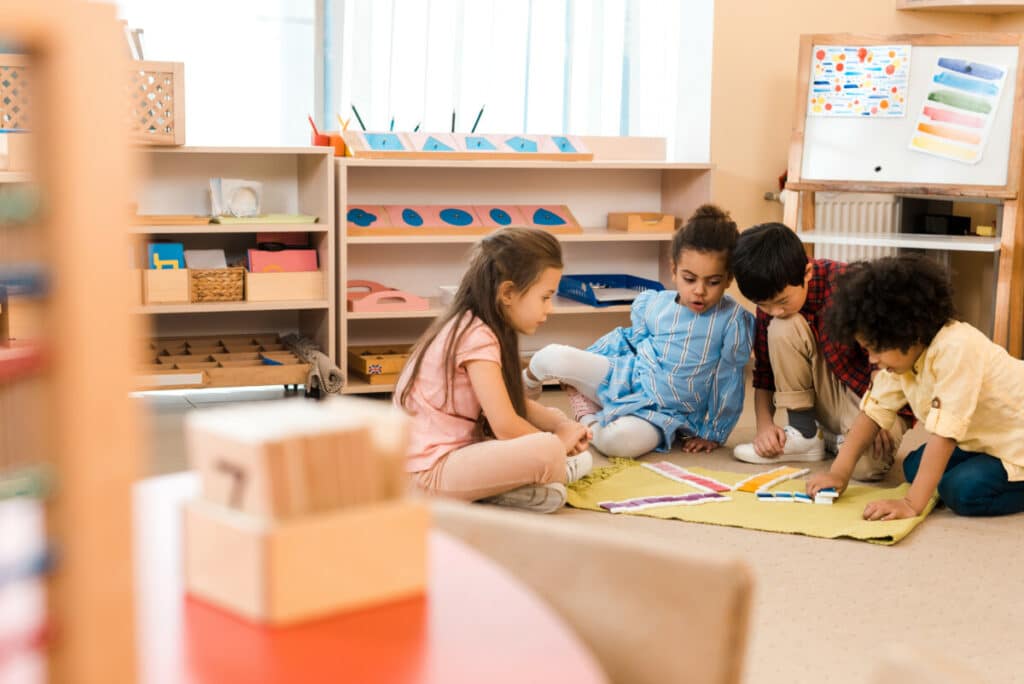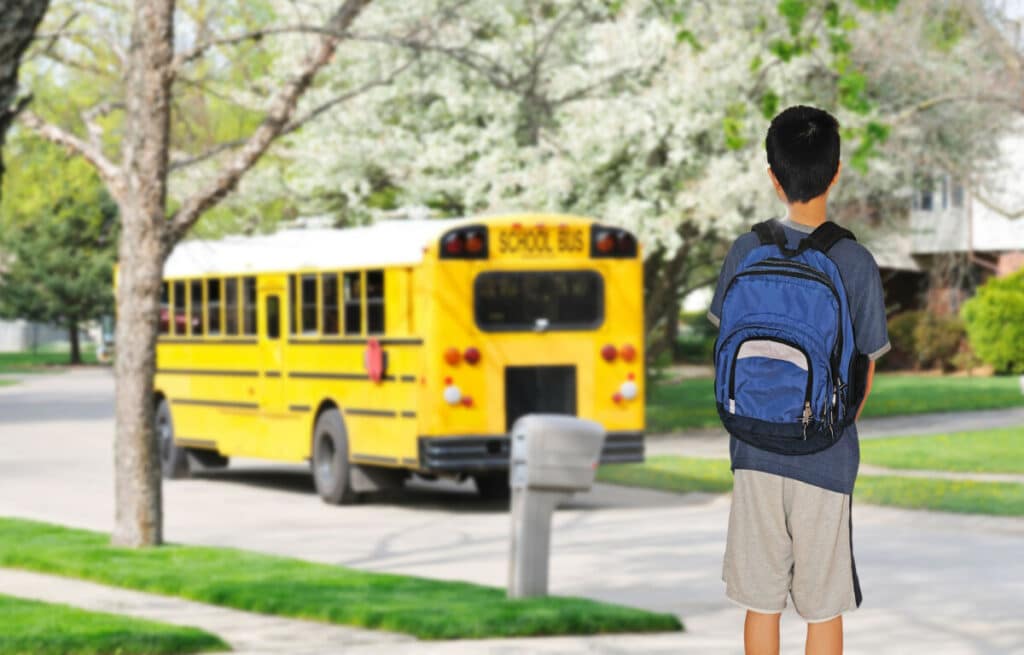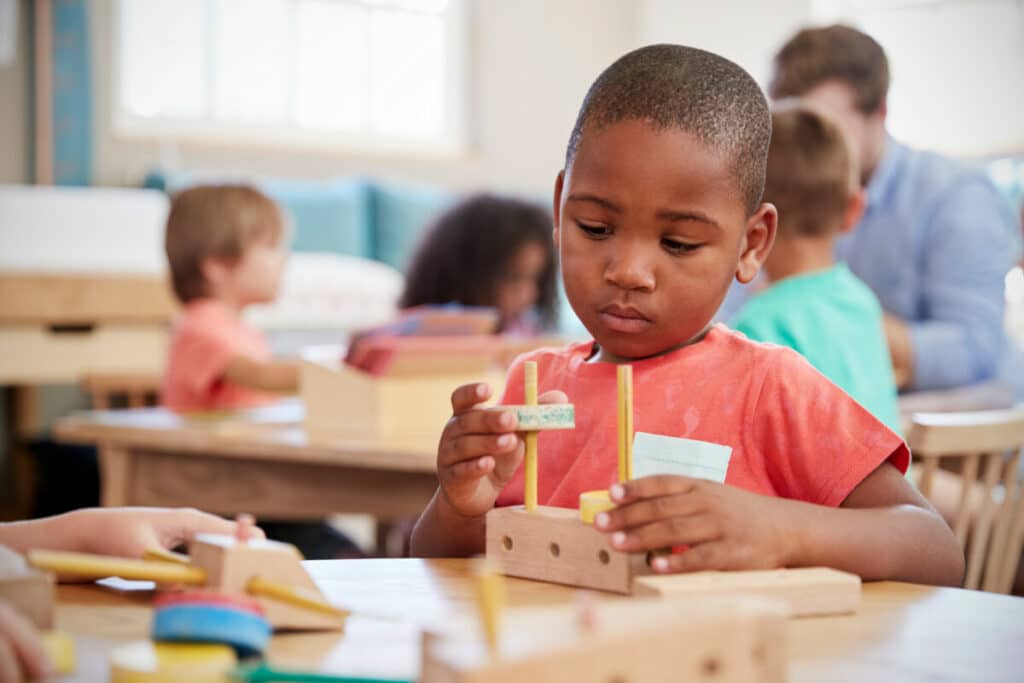Montessori vs Public Schools: 13 Pros and Cons
Public schools and Montessori’s are almost the complete opposites when it comes to schooling styles. Not one is necessarily better than the other, it mainly just depends on the specific school in your area, and the student attending. Both have advantages and disadvantages that can be offered to a child, so it’s important to do some research based on what the student needs.
Montessori schools are great for personalized, independent learning and mixed age groups. However, they can often be expensive and inaccessible. Public schools are good because they are free, widely available, and diverse. However, they often have a lack of funding and individualized attention.
Keep reading to understand the pros and cons that come with public schools and Montessori schools.
Montessori Pros

There are many great things about enrolling your child in a Montessori school:
- The emphasis on hands-on independent learning: Students get to use different objects and sensory-based materials, like geometric solids and sandpaper letters for example.
- Students learn at their own pace: These schools allow children to work, develop, and learn at their own pace instead of making them all learn at the same rate.
- Great social interactions: Montessori schools group children together including different ages in the same learning environment. The classrooms are often mix-aged and involve a lot of peer-to-peer learning. Teaching each other and learning from others in the group leads to more growth that is harder to experience in regular-aged schools.
- Independence is the backbone: Montessori schools are better at developing a sense of confidence and creative freedom. Most of the learning process is self-directed, which allows children to grow independence and be confident in their capabilities.
- Encourages a love for learning: A common long-term impact of Montessori learning is that Montessorians stay curious about the people and world around them. It increases people’s interest in learning that they are able to have throughout their life, versus doing assignments in traditional schooling just to graduate or pass a class.
- It’s special-needs-inclusive: Maria Montessori always aimed to include children with special needs for the whole duration of their time at school. She studied intellectual and development disabilities, along with being the co-director of an institute for special education teachers. Special needs students usually have less pressure to keep up with others in the group and are able to learn at their own pace because everyone’s grouped with different ages and has the same teacher for three years at a time. (Source)
- Focus on key developmental stages: These schools focus on key developmental milestones for children between 3 to 5 years old. Skills they focus on would be muscle and language skills, fine motor skills, completing everyday activities, and opening their eyes to communities through trips and events.
- Encourages cooperative play: Unlike traditional schools, a teacher doesn’t direct the classroom. Instead, the students direct the activities. In this environment, children understand how to respect each other and grow a feeling of community.
- Creativity is encouraged: Montessoris allow students to choose their own activity and complete them how they would like. Since they work on projects to enjoy work rather than completing them, there’s naturally more creativity that sparks throughout the process.
- Children gain a sense of order: A sense of order learned in a Montessori school helps teach children self-discipline. This happens by placing objects in their designated locations after activities, for example. (Source)
- Students are in a mixed-age group: Children are interacting with a mixed-age group, which can help them develop social skills; older kids get the chance for leadership roles, and younger kids can learn from their peers.
- Project-based work: Especially during the elementary ages, learning is regularly project-based instead of having to memorize lists and completing worksheets.
- Homework is rare: There’s almost never homework assigned, which avoids busy work. You come to school and learn what you need to during your school day. (Source)
Public School Pros

Now that we’ve talked about the pros of Montessori schools, let’s talk about all of the benefits of attending public schools:
- It’s free: The best part about public schooling is that there is no cost to attend. Children can get an education for free since the funding comes from the state government.
- Accessible transportation: There’s free and accessible transportation for kids to get to and from public schools. The bus system is a huge benefit to a lot of families, especially those who don’t have any other option to send their child to school safely.
- Extracurriculars: Most public schools offer different activities for students to participate in. Through clubs, sports, and arts, they’re all free and allow kids to practice hobbies while having fun. It’s also nice to have this option available if parents can’t afford to pay for them to take lessons or engage in these activities outside of school.
- Provide services for students with disabilities: Usually, public schools supply services needed for students with disabilities for free, because of the Exceptional Student Education program. (Source)
- It’s available to almost everyone: While it’s often hard to find a Montessori or private school near you, there is always a public school in the area. They’re accessible to every child in the community, and they’re legally not allowed to turn kids away regarding academic performance, income level, or any other factor.
- There’s diversity: Since it’s an option for all children in the community, children are surrounded by other people who are different than themselves. Students work with other kids who might have different income levels, cultures, mental or physical disabilities, and family life. Experiencing school with a diverse group of peers can be a good learning experience on its own.
- Academic opportunities: Public schools have different opportunities such as advanced classes in different subjects. The resources from the school are often very beneficial to students, it’s just a matter of whether the student decides to take advantage of those resources or not.
- Lower pressure for students: Something that’s common at private schools is the high level of pressure students face from the school. Especially if it has a good reputation, it will push for students to keep scoring well and achieving high. With public schools, there is a lot less pressure put on the students. (Source)
- They offer different services: It is enforced by law that public schools must supply specific services. For example, this could include reduced-priced lunches or academic assistance for students that meet the qualifications. There’s also a school nurse available at every public school, which is another service that’s great to have if it’s needed.
- Teachers must reach qualifications: Teachers are required to be certified by the state in order to teach at public schools. This certification needs ongoing education and frequent renewal, which means that parents can count on the people teaching their kids to have the right skills and knowledge.
- Accountability: The state holds public schools accountable for their academic performance. Each school has to answer to the state, which stops abuse and allows failing schools to be taken care of.
- Students succeed comparably to other schools: Compared to other private schools, public school students score generally the same on standardized tests. Public schools’ results are sitting at the same level as other schools. (Source)
- Sense of community: Public schools tend to create a sense of community for students since they are going to school with kids in their neighborhoods. They get to learn together and play together, and most of the time live close by. (Source)
Montessori Cons

While there are many great benefits of Montessori schools, there are drawbacks as well.
- Expensive: Due to the high-quality learning materials and in-depth training, Montessori schools are usually more costly. This is one of the biggest downsides to a Montessori school—it is an expensive form of schooling.
- Not as accessible: Even though Maria Montessori wanted it to be available to everyone, thats not the case. Most of the Montessori programs are private, charge tuition, and regulate admission. Because of this aspect, it’s harder for low-income, inner-city students to attend.
- Learning methods can be too loose for people: Since teachers don’t guide students through activities, often people find it too loose. Montessori schools have an approach they call “following the child,” which can be effective or create too much space for subjects to not receive proper attention/learning.
- Can teach unreal idea of independence: A key concept that Montessori’s implement is independence and self-guided work. On the other hand, most employment situations aren’t always like that. Even though the entrepreneurial aspect can be beneficial, it also can make it difficult for students to work in teams in a work environment. The workforce involves a lot of team-oriented environments, which is the opposite of how Montessori students are taught to think on their own terms.
- The open-ended structure can be intimidating: Routines and structure are things that children usually like, even the comfort of desks adjusted in rows for example. Classrooms in Montessori’s are assembled to allow a lot of movement, where the teachers guide but hardly instruct. While regular schools don’t provide as much room for movement, they can make students feel safe, and the environment is structured with routines.
- Minimizes the importance of friendship: There are very small class sizes in Montessori schools, which can be a disadvantage for developing friendships. It’s hard for students to find friends when there might only be one or two children around their age.
- Can be hard to adjust to other types of schools: After a student has been attending a Montessori school, it’s usually hard for them to adapt to the structures of traditional schools. Having to sit down in a classroom and read textbooks might even make them uncomfortable.
- A student has to learn self-motivation to be successful: There will be students who are motivated to do other things with their time than to learn certain skills they will need to be successful. If they don’t have direct interventions, they can fall through the cracks and be a detriment to their future career.
- Any school can claim to be Montessori: There are no specific guidelines or restrictions for a school to be called “Montessori.” Parents must do their research to figure out if the school meets their needs and has an authentic teacher. Read up on accreditation for Montessori Schools before you proceed.
- Provide your own transportation: Unlike public schools, there isn’t a transportation option available for students, and parents are forced to take their kids there and back every day.
- Transitioning out of Montessori schools: Down the road, parents often are worried about when their child has to transition out of a Montessori school. Whether it’s into a different school type, college, or career, it will be quite the transition for them.
- Inconsistent research results: There is not a reliable conclusion or data showing that students who attend Montessori schools versus public schools have better outcomes.
- Inconsistent educational methods: Not all schools follow the exact same educational methods that Dr. Montessori developed. Most usually use the basic program, but depending on what each one implements, this can affect the student’s outcomes. (Source)
Public School Cons

There are many drawbacks to public schools as well:
- Standardized tests: Students are required to take lengthy tests frequently for the government to gauge the school’s accountability. Every state includes tests, and it takes up a lot of time that could be spent learning. Not only do a lot of students dislike these tests, but they’re not always an accurate analysis of the teacher’s accountability or student achievement, since they don’t demonstrate a student’s academic growth.
- Advanced students aren’t as challenged as they could be: Different subjects are taught to everyone, no matter the skill and advancement level a student contains for that subject. Kids who are advanced usually aren’t challenged as much as they could be, and they can’t move ahead until the rest of the class can. (Source)
- Larger class size: Public schools often conduct classes that are made up of around 25 to 30 students. Since these schools go for 7 hours throughout the day, the teacher is splitting up this instructional time between all these students. This would calculate to each student gets about 12 minutes one on one with the teacher a day, which isn’t a lot of time.
- Bullying and violence: According to the statistics, a large number of young children between the ages of 8 to 12 have reported being bullied. Out of the bullying reports, there was a higher percentage of public school students reporting that bullying took place on school grounds. With the large number of students that attend public schools on a daily basis, there is a lot of bullying, and it’s hard for teachers to regulate at times unless a student reports it themselves.
- Disproportional resources: While the funding for public schools comes from the federal government, some of it comes from local taxes. This gives some students a lack of funds if they’re from a low-income area. For example, some affluent schools receive a lot of donations from parents, and they’re able to fund music teachers or other programs, which is an unfair advantage over lower-income students.
- Attention deficit and fatigue: As a result of public schools’ longer school days, it can lead to students losing their attention and becoming fatigued. When students are working and learning all day, they can become very exhausted, and the last hours of the school day are a waste. By the end of the day, students face an attention deficit, and some of the time they spend at school is useless.
- Funding: Citizens of the community have to pay higher tax property taxes to fund the public schools. Although, private schools must pay tuition, which can also be raised to cover costs. (Source)
- Lack of individualized attention: Because of the larger class sizes, students at public schools don’t typically get the individualized attention from teachers that could help them learn, especially not enough time to learn how different students learn better with different styles. (Source)
- Student accountability: In a classroom with 30 students, it’s easier for children who are shy or unprepared to hide in a way and not participate. There is less accountability that students feel when it comes to getting comfortable and participating in their classes.
- Takes time for new methods to be implemented: A disadvantage of public schools is the amount of time it takes for a new innovation to be implemented into the curriculum. Private schools usually start new innovations faster. (Source)
- Can have lower diversity levels: When public schools are separated by higher-income areas being grouped together, and lower-income areas being grouped together, this can lead to lower diversity within the school. This all depends on the boundaries of the district but does happen.
- Less flexibility regarding the curriculum: A con to public schools is that they don’t have as much flexibility when it comes to the curriculum as private schools do. Private schools can offer subjects that might not even be taught in public schools.
- Lack of different teaching methods: Teachers in public schools usually teach all their students in the same way, and there’s not as much of a variety to grasp subjects for different students. This is a downside to public schools that private schools are able to do differently. Private schools can often offer alternative teaching styles. (Source)

